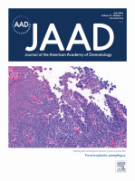Tacrolimus (FK506) ointment for atopic dermatitis: A phase I study in adults and children - 09/09/11
Abstract |
Background: Tacrolimus is a potent immunosuppressant used in organ transplant recipients; an ointment formulation is being developed as a therapeutic agent for atopic dermatitis. Objective: Our purpose was to define the pharmacokinetics and evaluate tacrolimus 0.3% ointment as therapy for moderate to severe atopic dermatitis. Methods: Thirty-nine patients, 5 to 75 years of age, received 14 applications over 8 days. Serial blood samples were collected on days 1 and 8, with predose samples collected on days 2 through 7. Overall response and signs/symptoms were rated daily on days 1 through 11. Incidence of adverse events and laboratory profile were determined. Results: Mean area under the curve (0.9 to 42.5 ng ·hr/ml) was highly variable and appeared to be related to size of application area. No systemic accumulation of tacrolimus was observed. Comparison to historical intravenous data indicates that absolute bioavailability of topical tacrolimus was less than 0.5%. Ninety-five percent of patients showed at least good improvement. All adverse events were transient. Burning was the most common application site adverse event and vasodilatation ("flushing/warmth") was the most common nonapplication site adverse event. No drug-related changes in laboratory profile were observed. Conclusion: The results of this study suggest that tacrolimus 0.3% ointment may be a safe and effective therapy for atopic dermatitis. (J Am Acad Dermatol 1998;38:69-76.)
Le texte complet de cet article est disponible en PDF.Plan
| From the Department of Dermatology, University of Illinois at Chicago a; the Department of Dermatology, University of Michigan, Ann Arbor b; and Research and Development, Fujisawa USA, Inc., Deerfield. c |
|
| Supported in part by Fujisawa USA, Inc. |
|
| Reprint requests: Virginia C. Fiedler, MD, University of Illinois at Chicago, Dermatology Clinical Research Unit, 840 S. Wood St., M/C 624, Chicago, IL 60612. |
|
| 16/1/87477 |
Vol 38 - N° 1
P. 69-76 - janvier 1998 Retour au numéroBienvenue sur EM-consulte, la référence des professionnels de santé.
L’accès au texte intégral de cet article nécessite un abonnement.
Déjà abonné à cette revue ?

